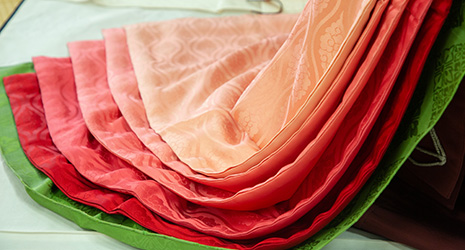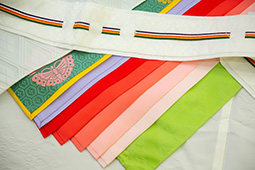INDEX
- English
- 日本語

The kobai no nioi (gradation of color of red plum) combination from the kasane no irome - English
- 日本語

The five layers of the junihitoe are visible at the collar, sleeves and hemline

The kobai no nioi (gradation of color of red plum) combination from the kasane no irome 
The kurenai no nioi (gradation of scarlet) color combination
October 2020
Kimono Combinations: The Seasons in Layers of Silk

The kimono worn by women of the Heian court were arranged in layers in accordance with a color code that borrows from the changing hues of the passing seasons.

Plum blossoms heralding the coming of spring change color gradually, from deep red buds to soft pink flowers. Drawing on such natural seasonal changes of colors, in the Heian period (late eighth to end twelfth century) the nobility drew up a set of rules for the color combinations of the layers of silk kimono that were worn by women and men in the imperial court. Presented in “layer color combination” charts called kasane no irome, more than 100 possible color patterns are enumerated. For the nobility of the Heian court, how to dress appropriately and elegantly to match both the season and the occasion based on Kasane no irome was indispensable knowledge.
The kasane no irome are most strikingly put to use in the itsutsuginu-karaginu-mo set of robes collectively called junihitoe, the formal court dress for women worn at ceremonies and on other important occasions. In the junihitoe arrangement, five different colored robes, called itsutsuginu, are layered on top of the hitoe undergarment. Each of the itsutsuginu layers is only slightly visible at the collar, sleeve edges and hemline. At first junihitoe comprised twelve or more layers of kimono, but five layers became standard around the end of the Heian period. Women took pride in the elegance and timely beauty of the color combination of the robes they selected.

Shoji Reiko, principal of the Kokusai Bunka Technical College of Hairdesign, Tokyo, returns to the plum blossom example.
“The combination of the colors of plum blossoms that change over time is called kobai no nioi (gradation of colors of red plum). In the five layers of kimono worn in this arrangement, a red layer blends into four layers of lightening shades of pink. This color combination is appropriate for special occasions celebrated in early spring.”

According to Shoji, safflower and other natural pigments were used to achieve the subtle color gradations.
By using layers of silk with a white outer layer and dark colored inner layers, the outer layer of some kimono take on certain shades of color. For example, a kimono with a white outer layer and a red inner layer has a pale red tone, the color of cherry blossoms.
Shoji says, “The aristocrats of the Heian period created kasane no irome to treasure the transience of the four seasons. The shades or expressions of the color red, for example, are of great variety. We can say that this is a culture that recognizes and enjoys the beauty of various colors, a natural feature of Japan where the seasons are constantly changing in subtle ways.”


